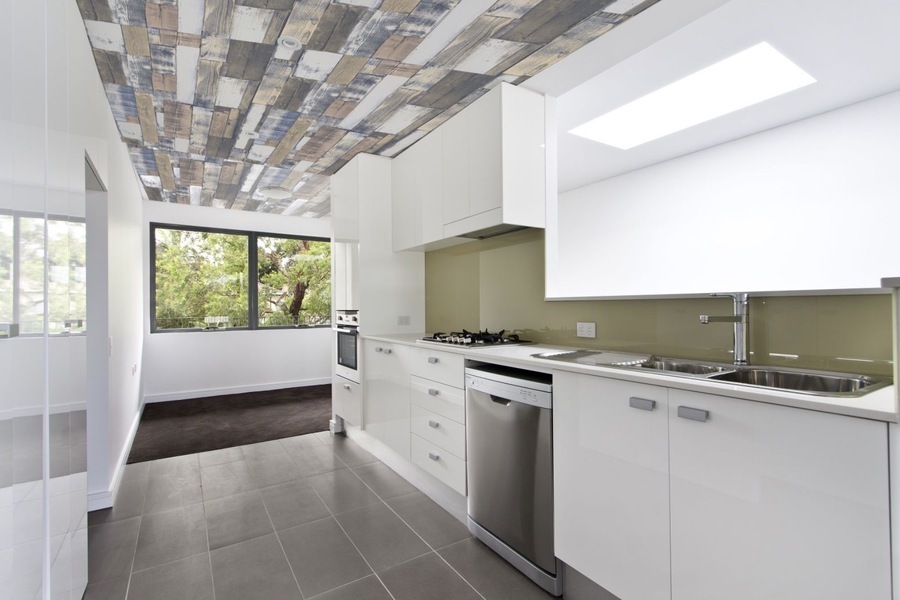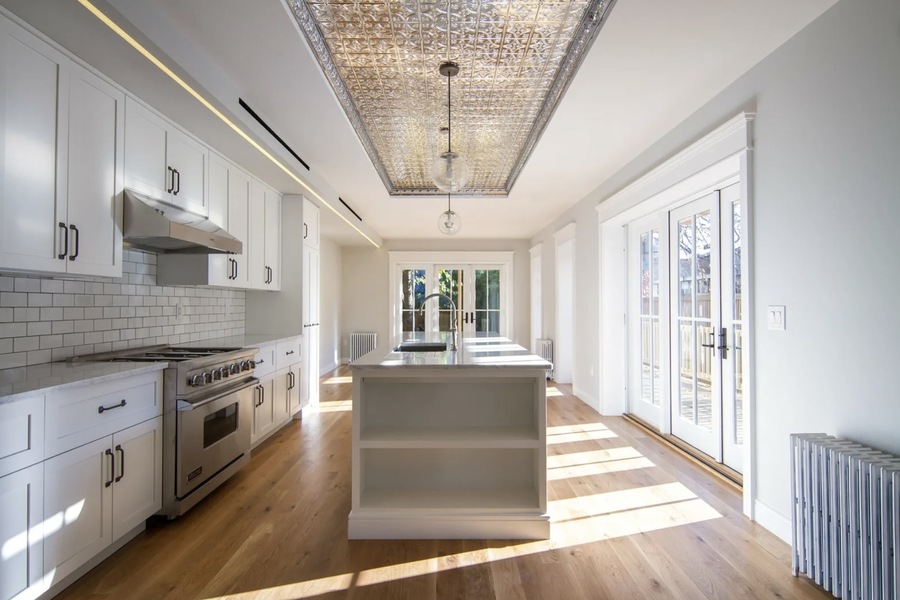Incorporating statement ceilings has become an emerging trend in modern architecture and interior design. Often referred to as the “fifth wall,” ceilings now serve as decorative elements, not just functional components. One creative approach gaining popularity is the use of subway tiles. Known for their clean lines and versatility, subway tiles are typically used on walls and backsplashes, but they also offer unique possibilities for ceilings. In Dubai and the UAE, where design aesthetics blend modern and traditional influences, subway tiles on ceilings present a bold way to redefine spaces in both homes and offices.
Why Use Subway Tiles on Ceilings?
Using subway tiles on ceilings offers both visual appeal and practicality. Their geometric patterns enhance ceiling texture, making the space appear more structured. This method also works well for smaller spaces by drawing the eye upward, creating the illusion of height. Additionally, subway tiles are easy to clean and maintain, making them ideal for both residential and commercial spaces.
Tiles also offer durability, especially in humid environments like bathrooms and kitchens where ceilings may need extra protection from moisture. RAK Ceramics, a well-known brand in the region, provides subway tiles with finishes that are resistant to stains and discoloration, ensuring long-lasting performance.
Choosing the Right Subway Tiles for Ceilings
Selecting the right tiles depends on the ceiling’s function and location. Glossy subway tiles reflect light, making them ideal for spaces that require more brightness, such as kitchens or office lobbies. Matte tiles, on the other hand, provide a more subtle appearance, suitable for bedrooms or living rooms.
Tile size is also important—smaller subway tiles fit well in compact rooms, while larger tiles work better for expansive ceilings, as they reduce grout lines and create a cleaner look. Color selection plays a significant role too. White tiles offer a minimalist, airy feel, while black or dark gray tiles introduce contrast and depth, especially in modern interiors.
Installation Considerations for Ceiling Tiles
Installing subway tiles on ceilings requires precise planning to ensure they remain secure and aligned. Proper surface preparation is essential—ceilings must be flat and dry to allow the adhesive to bond effectively. Special attention should be given to weight distribution, as ceiling tiles need strong adhesives designed for overhead use.
Aligning the tiles correctly ensures visual continuity. A running bond pattern, where tiles are offset like bricks, is common for statement ceilings and adds visual interest. For spaces with curved or irregular ceilings, creative layouts such as diagonal or vertical arrangements can highlight architectural features.

Integrating Ceiling Tiles with Lighting Fixtures
Lighting design complements the aesthetic value of a tiled ceiling. Recessed lighting works well with subway tiles, as it emphasizes the tile pattern without obstructing the surface. Pendant lights or chandeliers, when placed strategically, can create focal points that enhance the overall design.
For offices, combining tiled ceilings with LED strips along the edges creates a sleek and modern look, while in homes, warm lighting can soften the structured appearance of subway tiles. Matching the grout color to the lighting tone ensures a cohesive design, particularly in spaces like meeting rooms or living areas.
Using Subway Tiles for Statement Ceilings in Homes
In residential interiors, subway tiles are an excellent choice for creating unique ceiling designs. Kitchens and bathrooms benefit the most from tiled ceilings, as they not only provide visual appeal but also protect against humidity. In open-plan living areas, using subway tiles on the ceiling above specific zones—like dining areas—helps define spaces without the need for physical partitions.
Bedrooms can also feature tiled ceilings, especially above the bed as a decorative element. Opting for softer tones such as light gray or cream subway tiles introduces subtle texture while maintaining a calm atmosphere. This approach complements Dubai homes, where minimalist yet luxurious interiors are favored.
Subway Tile Ceilings in Office Spaces
In commercial spaces, subway tiles add character to otherwise standard office interiors. Lobby ceilings with subway tiles make an immediate impression, giving visitors a sense of sophistication. In meeting rooms, tiled ceilings introduce an element of focus, particularly when paired with simple wall designs.
For co-working spaces, subway tile ceilings can enhance specific zones, such as break areas or lounges, creating a more welcoming environment. Using neutral tile colors ensures that the design remains versatile, allowing the space to adapt to future changes in furniture or branding.
Maintenance and Durability
Subway tiles are known for their durability and ease of maintenance, making them suitable for ceilings that need to remain visually appealing over time. Regular dusting or wiping with a damp cloth is typically enough to maintain their appearance. For bathrooms and kitchens, occasional cleaning with a mild cleaner prevents the buildup of grease or moisture.
In commercial settings, subway tile ceilings are a practical solution, as they withstand wear and tear better than painted surfaces. Their moisture resistance also makes them a suitable choice for spaces such as restaurant kitchens, where ceilings are prone to humidity and stains.
Cost and Practicality
While installing subway tiles on ceilings involves higher labor costs compared to walls or floors, the long-term benefits outweigh the initial expense. Tiled ceilings require minimal upkeep and have a longer lifespan than traditional ceiling finishes, making them a cost-effective option in the long run.
For those working with a budget, using subway tiles selectively—such as in feature areas or recessed sections—achieves the desired effect without tiling the entire ceiling. This approach works particularly well in both small apartments and large villas, where strategic use of tiles enhances design impact.

Creative Layouts for Statement Ceilings
Experimenting with different subway tile layouts creates distinctive ceiling designs. A diagonal arrangement, for example, introduces movement, making rooms appear more dynamic. Vertical layouts elongate the space, adding height to rooms with lower ceilings. In contrast, a horizontal layout reinforces a sense of stability, making it suitable for office meeting rooms or home libraries.
Grout color also plays a role in the final look. High-contrast grout enhances the tile pattern, making it more prominent, while matching grout colors create a seamless surface, perfect for minimalist interiors. These creative design options allow homeowners and designers to customize the appearance of any space.
Using Subway Tiles to Define Multi-Use Spaces
In both homes and offices, subway tile ceilings help define multi-functional spaces. For example, in open-plan offices, tiled ceilings above collaborative areas create visual separation from workstations. Similarly, in homes with open living and dining areas, a tiled ceiling can mark the dining zone, enhancing the flow of the space.
The ability to use the same tile style across different sections ensures cohesion throughout the property. This design technique is particularly relevant for Dubai villas and offices, where open spaces and multi-use zones are common.
Conclusion
Subway tiles offer a practical and aesthetically pleasing way to enhance ceilings in both residential and commercial interiors. Their versatility allows for a variety of layouts, colors, and finishes that suit different spaces and design goals. In Dubai and the UAE, where architectural styles emphasize elegance and modernity, subway tile ceilings provide a unique way to elevate interiors. With options from RAK Ceramics offering both durability and style, homeowners and businesses can achieve statement ceilings that are as functional as they are beautiful.

Я отмечен наградами писатель-фрилансер, специализирующийся на финансовых темах. Я имею в виду более чем десятилетний опыт работы, о котором упоминалось в The Wall Street Journal.
